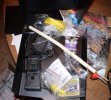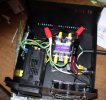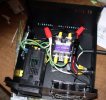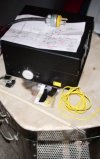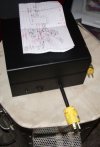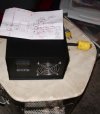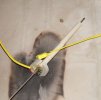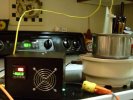When you are ready to test it out, boil a pot of water on the stove and stick the TC in it. Turn the PID on and set the target for 200F. Plug a table lamp ( or any light) into the controlled socket ( make sure it is turned on).
The temp reading should be about 210-212F ( it may vary, thats OK, as long as it is above 200F). The lamp should be off. You should have an "over-target" or "alarm" light. If all is well, turn off the stove burner, and slowly pour cool water in the pot while stirring. The temp should drop, and at 195-200F the lamp should come on. The actual readings may vary, but as long as you are within the area, all is well. Now, turn the burner back on and stir the pot. As the temp comes back across 200F, the lamp should go off. Again, it may be higher or lower, but it should turn the lamp off at some point near 200F. Do this several times, so the PID can "learn" to control the process.
If those tests gave you reasonably close readings, and the unit turned the power on and off, the PID control is ready to install on the kiln. Try some test settings at moderate temps first, like 1000F, and see how the unit cycles.
Let it run for a while, as the PID will need to "learn" the time it take to return the oven to temp. Each cycle tels it how long to run the coils to boost the temp back up. In the first cycles, it will overshoot and undershoot. then it will start to fine tune the timing and get so it stays +/- a few degrees. This is an important thing to understand, as sticking the blade in the oven too soon may expose it to the larger swings while the PID is learning.
Compare the PID to a teenager learning to drive. At first they over correct their steering, and swing back and forth from left to right as they go down the road. But, soon their brain will figure out just how long to turn the wheel before bringing it back....and the car goes straight down the road. The reason they use rubber cones and not other cars on the driving course for beginners, is that at first they will run over a lot of cones until they learn to steer. ( Yes, I used to teach Drivers Ed)
You can use things like Templi-stix or even salt to try and check your PID accuracy at the 1500F range, but unless you think the TC is way off in its readings, just find the readings that work for your unit and use them. On your PID, 1500F may read 1470 or 1520. That isn't really such a problem, as long as you know that the temp being read will deliver a certain result. Keep good records on firing cycles, and you will soon know the temperature to set your oven at to get the desired HT result. One reason you see people post things like " I set my PID at 1473F and...." is that they have found that 1473F works exactly right for their setup. It may be 1485F, or 1465F...doesn't really matter - on their oven it reads 1473F.

